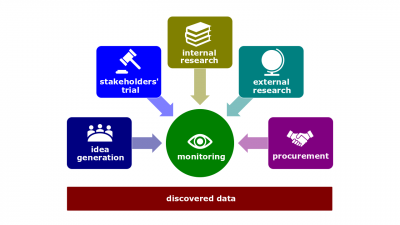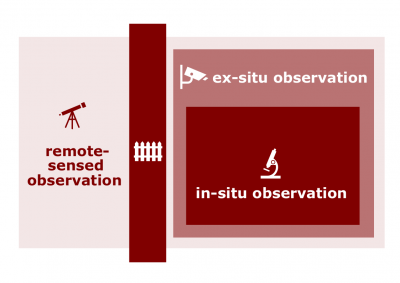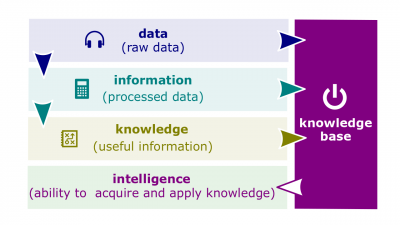Monitoring Quarter
Monitoring Quarter (hereinafter, the Quarter) is a lecture introducing the learners to operations discovery primarily through key topics related to monitoring. The Quarter is the first of four lectures of Operations Quadrivium, which is the third of seven modules of Septem Artes Administrativi (hereinafter, the Course). The Course is designed to introduce the learners to general concepts in business administration, management, and organizational behavior.
Contents
Outline
Project Management Quarter is the predecessor lecture. In the enterprise discovery series, the previous lecture is Validated Learning Quarter.
- Operations discovery is the enterprise discovery of data needed to design or modify operations that enterprises run in order to support their businesses. Organizationally, the data needed to design or modify these operations is collected through idea generation, validated learning, monitoring, and market intercourses. This particular lecture concentrates on monitoring because this enterprise effort is the primary method for collecting data that routinely emerges.
Concepts
- Monitoring. A continuous process of collecting enterprise data.
- Internal monitoring. Monitoring of internal data sources; these sources include document collaboration systems, business surveillance, enterprise acquisitions, communications, and the bookkeping system.
- Market monitoring. Monitoring of industry contracts, market data, and competitive intelligence.
- Stakeholder monitoring. Monitoring of stakeholders.
- Regulatory monitoring. Monitoring of regulatory information.
- Enterprise discovery. All activities resulted in obtaining of any data relevant to further effort development undertaken in order to achieve the effort goal or goals.
- Indicator. An indicator identifies a specific numerical measurement that indicates progress toward achieving an impact, output, activity or input. See also metric.
- Data collection mode. A way or manner in which monitoring occurs.
- Automatic data collection. The data collection mode that automatically collects enterprise data.
- Controlled data collection. The data collection mode that requires a human intervention in order to collect enterprise data.
- Automatic surveillance. The automatic data collection of behavior, activity, or other changing enterprise data for the purpose of enterprise administration.
- Audiovisual surveillance. Business surveillance that uses microphones and/or cameras for observation from a distance. This surveillance may include aerial vehicles or closed-circuit television (CCTV).
- Digital interception. Business surveillance that intercepts electronically transmitted data such as Internet traffic, phone calls, social media or Global Positioning System (GPS) exchanges.
- Enterprise data. All data that has been gathered to support all of the enterprise efforts.
- Data. Factual communications, raw documents, unprocessed measurements, and/or recorded observations collected for further analysis in order to create information.
- Biological data. In enterprise administration, qualitative and/or quantitative data of employees. This data may include biological characteristics, pictures, videos, and other depictions, etc.
- Primary data. (1) Data collected specifically for the particular research; (2) Data specifically extracted from previously collected data for the particular research.
- Qualitative data. Data that approximates or characterizes, but does not measure the attributes, characteristics, properties, etc., of a thing or phenomenon. Qualitative data describes whereas quantitative data defines.
- Quantitative data. Data that can be quantified and verified, and is amenable to statistical manipulation. Quantitative data defines whereas qualitative data describes.
- Secondary data. Data that have been published, sold, and/or previously collected or extracted not for the current research.
- Metadata. Data about data; metadata is used to understand the context and validity of the primary and/or secondary data recorded in a system. If a photo is the primary data, its metadata might consist of what its resolution is, when the photo was taken, etc.
- Discovery metadata. Metadata that describes its primary data for discovery and identification purposes. It can include elements such as title, abstract, author, and keywords.
- Structural metadata. Metadata that indicates how data is organized internally, for example, how pages are ordered to form chapters, and externally, for example, how to find issues or discussions related to the primary data.
- Historical metadata. Metadata that provides historical data on any operations with the primary data such as its creation, storage, modification, verification, and/or validation. Historical metadata includes data sources, possibly, geolocations of data operations, contexts, maintenance records, test results, etc.
- Legal metadata. Metadata that provides data about intellectual property of the primary data and legal rights of its usage.
- Technical metadata. Metadata that indicates any technical data such as its file type, database key, archiving possibility, specifications, end-user documentation, etc.
- Data research. The systematic investigation into and study of data and data sources in order to further establish facts and reach new conclusions.
- Qualitative research. Data research that looks for qualitative data.
- Quantitative research. Data research that looks for quantitative data.
- Research inquiry. Enterprise effort undertaken in order to augment knowledge, to resolve doubt, or solve a problem.
- Ad hoc query. The ability to create a one-off, "on demand" report from BI or data analytics software that answers a specific business question.
- Appreciative inquiry. An approach that seeks to identify the unique qualities and special strengths of an organization, which can then be built on to improve performance.
- Data source. A place, person, or thing from which data comes or can be obtained.
- Internal data source. Intra-firm sources and records including historical data on similar procurements, cost and performance data on various suppliers and other data which could assist in proposed procurements.
- External data source. Extra-firm sources including industry contracts, market data, competitive intelligence and regulatory information which could aid procurement decision-making.
- Data origin. The point or place from which data can be collected.
- Human communications. Data generated by an informational exchange between two or more people.
- Document data. Data that one or more pieces of written, printed, or electronic matter contains.
- Media data. Data that one or more pieces of audio- and/or visual matter contains.
- Measurement data. Data that is obtained by one or more datapoint devices.
- Reconnaissance data. Data generated by observations.
- Data structure. The arrangement of and relations between the parts or elements of data.
- Structured data. Any data that is stored in a fixed field within a record or file. For instance, all data contained in relational databases and spreadsheets is structured.
- Unstructured data. Data that either does not have a predefined data model or is not organized in a predefined manner. Unstructured data is typically text-heavy, but may contain data such as dates, numbers, and facts.
Roles
- Data provider. An individual or organization that provides its customers with data.
- Surveillance target. Someone or something that is a target of surveillance.
Methods
- Media research. The data-gathering technique that is based on a systematic study of audio- and visual- materials in order to gather data.
- Observation. The data-gathering technique that is based on watching something or someone; an observation can also be a statement based on something one has seen, heard, or noticed. In business analysis, observation is a means to elicit requirements by conducting an assessment of the stakeholder's work environment.
- Documentation review (also known as documentation study, document research, and document analysis). The data-gathering technique that is based on a systematic study of documents in order to gather data. In business analysis, document review is a means to elicit requirements of an existing system by studying available documentation and identifying relevant information.
- Data import. Data brought into the bookkeeping records through a digital import. This could include bank transactions which can be downloaded from the bank in a special format such as CSV, or it could be contact names and addresses from another program such as excel. Import can also mean to bring into the country stock purchased overseas.
Instruments
- Content-gathering tool. A tangible and/or software implement used to gather content.
- Document form. A content-gathering tool implemented as one or more fields to be filled or options to be selected.
- Download portal. An online tool that is designed to download files.
- Data date (DD). The date at which, or up to which, the project's reporting system has provided actual status and accomplishments. Also called as-of date.
- Datapoint device. Any data-gathering tool that counts, detects, gauges, meters, records, scales, scores, senses, surveys, and/or tests somebody or something and is located at some point where relevant data can be gathered.
- Hazard detector. A tool used to identify or recognize hazards that are present or that could have been anticipated.
- Mobile data collection. A suite of mobile transactions designed for hand-held devices. This allows users to selectively deploy bar-code enabled, hand-held mobile devices.
- Observations tool.
- Observations and measurements (O&M). An international standard, ISO 19156:2011, that defines a conceptual schema encoding for observations, and for features involved in sampling when making observations. Although this standard has been defined for geographic information, its observation schema, observations data model initially developed to implement the standard, and other features are and can be used in a variety of industries.
- Observations data model. A model that relates (a) monitoring site locations, (b) observation values, (c) data sources, (d) data collection methods, (e) categorical data, and its variables, qualifiers, and groupings.
- Observation schema. A model that links observed results with those properties that have been observed and those procedures that have been used in order to obtain the results.
- Feature of observation interest.
- Observed property.
- Observed result.
- Observation procedure – the instrument, algorithm or process used (which may be described using SensorML)
- Observed phenomenon time – the real-world time associated with the result
- Observation result time – the time when the result was generated
- Observation valid time – the period during which the result may be used.
- Search engine. A software system that is designed to search for data on corporate networks or, as a web search engine, on World Wide Web.
- Document collaboration system.
Results
- Knowledge base. (1) A store of information or data that is available to draw on; (2) The underlying set of facts, assumptions, and rules that somebody or a computer system has available to solve a problem.
- Stakeholder register. A listing of the stakeholders affected by a business need or proposed solution and a description of their participation in a project or other initiative.
Practices
Controlling Quarter is the successor lecture. In the enterprise discovery series, the next lecture is Human Perceptions Quarter.


